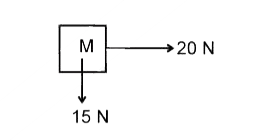In which direction the force of friction acts? What if object does not move?
Step-by-Step Solution:
1. Understanding the Direction of Friction:
- The force of friction always acts in the direction opposite to the direction of motion of an object.
- For example, if an object is trying to move to the right, the frictional force will act to the left, opposing the motion.
2. Friction When an Object is Stationary:
- If an object does not move, it means that the applied force is equal to the frictional force acting on it.
- This is because friction is a self-adjusting force. It adjusts its magnitude to match the applied force up to a certain maximum limit.
3. Maximum Frictional Force:
- The maximum force of friction can be calculated using the formula:
fmax=μ×N
where μ is the coefficient of friction and N is the normal force acting on the object.
- If the applied force exceeds this maximum frictional force, the object will start to move.
4. Conclusion:
- In summary, the force of friction always acts opposite to the direction of intended motion. If the object does not move, the frictional force adjusts itself to be equal to the applied force, preventing motion until the applied force exceeds the maximum frictional force.
- The force of friction always acts in the direction opposite to the direction of motion of an object.
- For example, if an object is trying to move to the right, the frictional force will act to the left, opposing the motion.
- If an object does not move, it means that the applied force is equal to the frictional force acting on it.
- This is because friction is a self-adjusting force. It adjusts its magnitude to match the applied force up to a certain maximum limit.
- The maximum force of friction can be calculated using the formula:
fmax=μ×N
where μ is the coefficient of friction and N is the normal force acting on the object.
- If the applied force exceeds this maximum frictional force, the object will start to move.
- In summary, the force of friction always acts opposite to the direction of intended motion. If the object does not move, the frictional force adjusts itself to be equal to the applied force, preventing motion until the applied force exceeds the maximum frictional force.
Topper's Solved these Questions
Similar Questions
Knowledge Check
The direction of force of friction
APerpendicular to the direction of motion of objectBAlong the direction of motion of objectCOpposite to the direction of motion of objectDNone of these.
The force of friction on a moving object always acts:
View SolutionThe force of friction on a moving object always acts:
View SolutionIn Figure an object of mass M=10kg is kept on a rough table as seen from above forces are appling on it as shown . Find the direction of static friction if the object does not move (Takeμ=0.4)

View SolutionIn the following figure an object of mass M is kept on a rough table as seen from above. Forces are applied on it as shown. Find the direction of static friction if the object does not move.

View SolutionIn which direction does the buoyant force on an object due to a liquid act ?
View SolutionA car moving towards North. What will be the direction of force of friction acting on this car due to surface of road ?
View SolutionForce of friction always act. Explain.
View Solution
